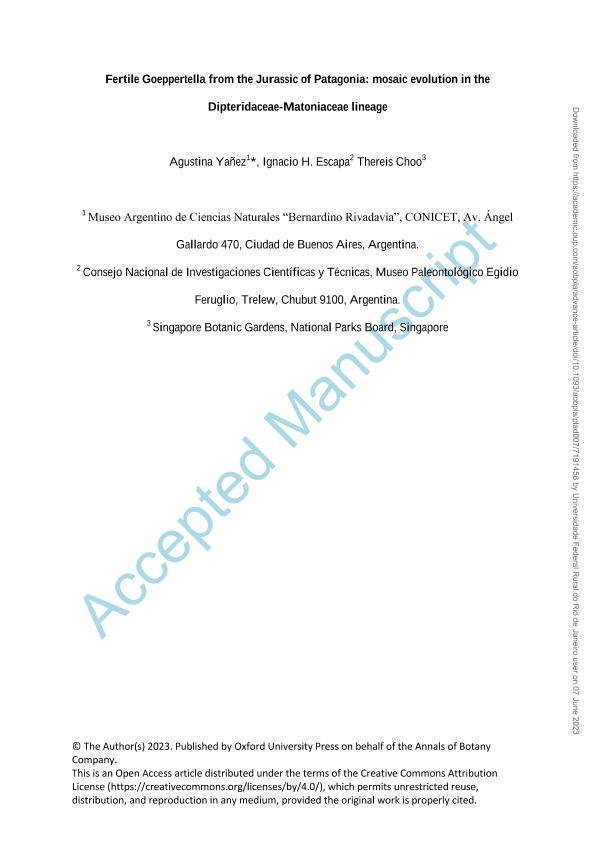Mostrar el registro sencillo del ítem
dc.contributor.author
Yañez, Agustina

dc.contributor.author
Escapa, Ignacio Hernán

dc.contributor.author
Choo, Thereis
dc.date.available
2024-03-06T10:59:10Z
dc.date.issued
2023-06
dc.identifier.citation
Yañez, Agustina; Escapa, Ignacio Hernán; Choo, Thereis; Fertile Goeppertella from the Jurassic of Patagonia: mosaic evolution in the Dipteridaceae-Matoniaceae lineage; Oxford University Press; AoB Plants; 15; 4; 6-2023; 1-46
dc.identifier.issn
2041-2851
dc.identifier.uri
http://hdl.handle.net/11336/229432
dc.description.abstract
Background and Aims: Goeppertella has been postulated as a monophyletic group, whose precise position within the Gleichenoid families Dipteriaceae and Matoniaceae, remains poorly understood. Previously described Goeppertella specimens are based on frond fragments and its fertile morphology is represented by a few, poorly preserved specimens. We describe a new species based on the largest collection of fertile specimens known to date, and discuss the evolutionary history of the genus based on the additional reproductive characters provided by the fossils described.Methods: Plant impressions were collected in Early Jurassic sediments of Patagonia, Argentina. The specimens were described, and silicone rubber casts were developed to examine in detail vegetative and reproductive features. The new species was compared with other Goeppertella species. Finally, a backbone analysis was performed in the context of a previously published combined matrix of Dipteridaceae, using the maximum parsimony criterion. Key Results: The new species is described based on a combination of features that have not been previously reported. The vegetative morphology shows affinities with most fossil and extant Dipteriaceae, contrasting with the reproductive morphology which is more comparable with the scarce number of fossil dipteridaceous forms and it is more spread in the sister family, Matoniaceae. The backbone analysis indicates that the position of the new species vary among different positions among Dipteridaceae and Matoniaceae. Additional analyses, discriminating the signal of reproductive and vegetative character, are provided to discuss the base of this uncertainty. Conclusions: We consider Goeppertella as a member of the family Dipteridaceae since we interpret most shared features with Matoniaceae as plesiomorphic conditions for the family. In contrast, most shared features with Dipteridaceae represent apomorphies for the group. Thus, Goeppertella would represent an early diverging genus in Dipteridaceae, considering the venation characters as the most important in order to define the family.
dc.format
application/pdf
dc.language.iso
eng
dc.publisher
Oxford University Press

dc.rights
info:eu-repo/semantics/openAccess
dc.rights.uri
https://creativecommons.org/licenses/by-nc-sa/2.5/ar/
dc.subject
Gleicheniales
dc.subject
Fósiles
dc.subject
Jurásico
dc.subject
Evolución
dc.subject.classification
Ciencias de las Plantas, Botánica

dc.subject.classification
Ciencias Biológicas

dc.subject.classification
CIENCIAS NATURALES Y EXACTAS

dc.title
Fertile Goeppertella from the Jurassic of Patagonia: mosaic evolution in the Dipteridaceae-Matoniaceae lineage
dc.type
info:eu-repo/semantics/article
dc.type
info:ar-repo/semantics/artículo
dc.type
info:eu-repo/semantics/publishedVersion
dc.date.updated
2024-03-05T11:23:57Z
dc.journal.volume
15
dc.journal.number
4
dc.journal.pagination
1-46
dc.journal.pais
Reino Unido

dc.description.fil
Fil: Yañez, Agustina. Consejo Nacional de Investigaciones Científicas y Técnicas. Oficina de Coordinación Administrativa Parque Centenario. Museo Argentino de Ciencias Naturales "Bernardino Rivadavia"; Argentina
dc.description.fil
Fil: Escapa, Ignacio Hernán. Museo Paleontológico Egidio Feruglio; Argentina. Consejo Nacional de Investigaciones Científicas y Técnicas; Argentina
dc.description.fil
Fil: Choo, Thereis. Singapore Botanic Gardens; Singapur
dc.journal.title
AoB Plants
dc.relation.alternativeid
info:eu-repo/semantics/altIdentifier/url/https://academic.oup.com/aobpla/advance-article/doi/10.1093/aobpla/plad007/7191458?utm_source=authortollfreelink&utm_campaign=aobpla&utm_medium=email&guestAccessKey=991ebb0a-a619-4bc3-9049-8a40505fe1d6
dc.relation.alternativeid
info:eu-repo/semantics/altIdentifier/doi/http://dx.doi.org/10.1093/aobpla/plad007
Archivos asociados
